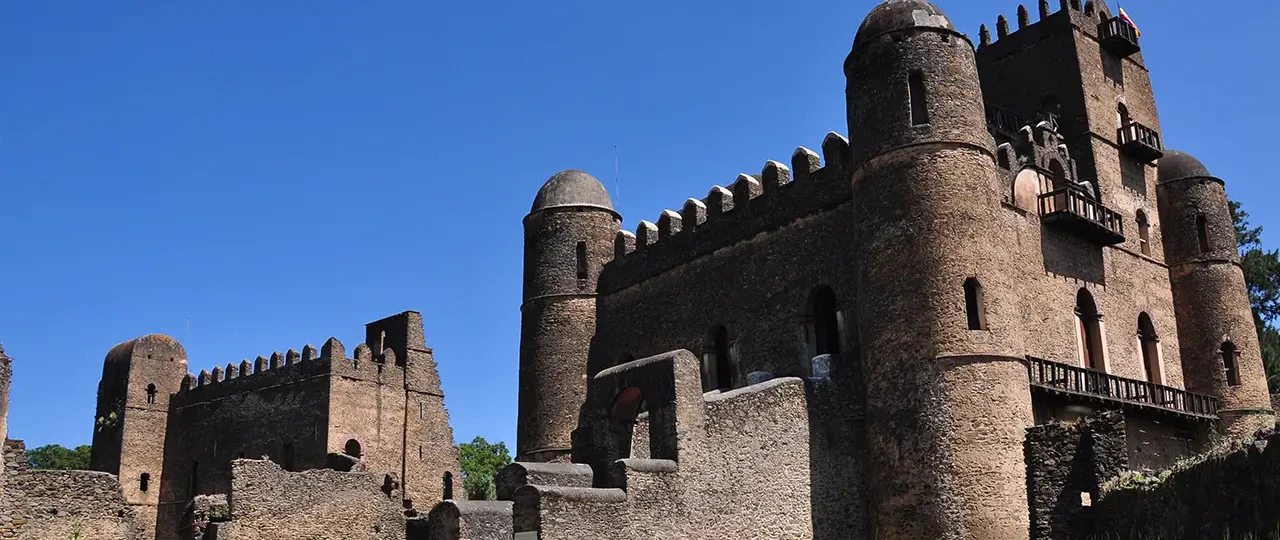Fasil Ghebbi, Gondar
Gondar, the medieval royal city, is distinguished by its castles and imperial compound and by its churches, particularly Debre Berhan Selassie, the walls and ceiling of which are completely covered in murals. On a second day, visitors could see the very fine and recently restored medieval church of Debre Sina Mariam at Gorgora, at the northern end of Lake Tana, or make a day trip to the Simien Mountains National Park.
Kossoye Queens Village
Found 30 kilometers from Gondar on the way to Aksum, Kosoye was known for its scenic beauty and usage as a camp when Queen Elizabeth of England visited Ethiopia in 1965. Standing to the west of the village enables us to watch the most stunning and gentile escarpment that slopes down to Sudan.
The Felasha Village
Situated three kilometers to the north of the city center, the small village of Weleqa was once inhabited by the Felasha community (Ethiopian Jews). Of its history and center of craftsmanship like earthen pots, Woleqa is one of the attractions frequented by tourists especially for earthen pots.
The Monastery of Qusquam
Founded by Empress Mintwab, the monastery of Qusquam and the ruined palace are situated to the west of the town at about three kilometers from the city center. Qusquam was the last flower of Gondar before the glory of the city wilted due to court intrigues and destructive civil wars. Here visitors can see the old church-ruined palace of the Empress, fine old manuscripts, and skeletal remains of the Empress, her son Iyasu II and grandson Iyoas.
The monastery of Debre-Birhan Selassie
The monastery of Debre-Birhan Selassie, built during the reign of Iyasu I, is famous, especially for its fine frescoes. The ceiling and the beams are painted with rows of winged angels and the wall with impressive biblical events that reflect the life of Christ, Mary, the Saints, and martyrs.
The church’s compound is also a botanical garden rich with giant junipers and old olive trees on which birds of different species nest. At the back of the enclosure is a traditional school where famous clerics of the nation learn church music, writing, and binding.
The Bath of Emperor Fasiladas
t is a kilometer away to the west of the city. We are told that during the heyday of Gondar, the bath had been used for sports and religious rites on the day of epiphany. But now it is employed only for the annual celebration of baptism. Nearby lays the tomb of Emperor Fasiladas’ great horse, Zobel.
The Royal Compound
Lying within 70,000 m2, the Royal Compound encompasses six lofty castles and many different buildings like the royal archive, the house of the musicians, the lion cage, the horse zoo, the sauna bath, the house of the spinners, etc. The earliest and grandest of all edifices is that of Emperor Fasiladas, which is 32 meters high and with battlemented square tower.
To the North of this castle stands the chancery of Emperor Yohannis I (r/1667-1682) and a splendid palace of Iyasu I (r/1682-1770). The palace of Iyasu was astonishingly embellished with ivory, gold, precious stones,s, etc. To the North West, lie Dawit III’s music hall, Emperor Bakafa’s banquet house, and Empress Mintwab’s palace. A huge circular wall with 12 gates forms the enclosure.
West of Emperor Fasil’s archive, there is the church of Gimjabet Mariam, /the treasury of St. Mary/ and the tomb of W.C Plowden, British consul to Ethiopia in the 19th c.

